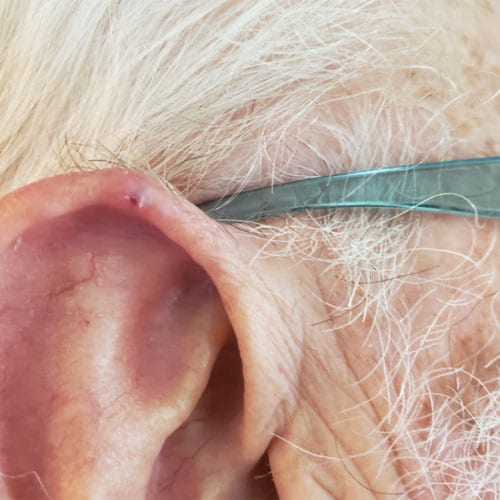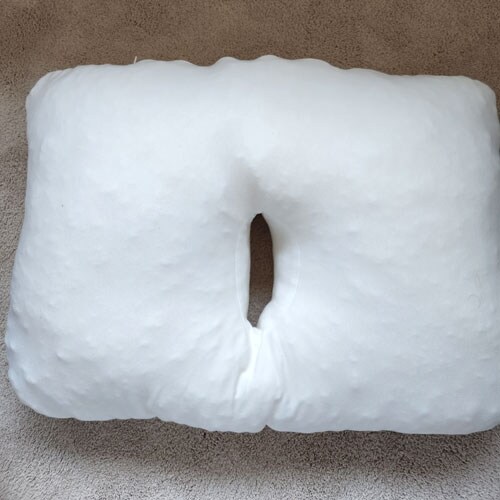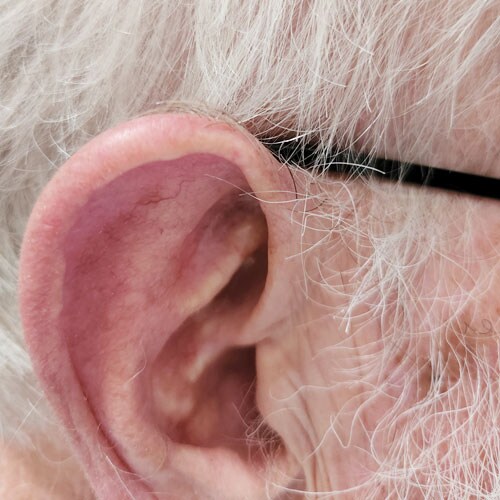"A doctor who treats himself has a fool for a patient." – Sir William Osler.
Sorry, Bill. I completely disagree. Whether or not you're a physician, you must be your own primary screener, diagnostician, therapist, and triage agent every day for the promotion of your own health, prevention of disease, and making an early diagnosis.
As we age, we gain additional opportunities to experience new and different diseases. Any good physician learns much from our patients, and even more from our own health.
I've gotten a lot of sun exposure during my life and not always with sunscreen. So when the superior aspect of my right external ear got red and a little swollen, it bothered me. Over days and weeks, it became a bit painful and seemed to "point," then drained some white material and healed up. Okay, maybe an odd staph infection. I thought nothing more about it.
Whoops. The lesion recurred in the helix of the right pinna after a few months and got worse in May 2021.

Figure 1. Right ear lesion
The thing about successfully being your own physician is honestly knowing and admitting what you don't know, recognizing that, and then confronting yourself about it. I did not know what this ear condition was, but I knew I did not like it.
I trust my local dermatologist, a pioneer in telemedicine. My wife has used his teledermatology service successfully. So I registered at his site, provided some clinical information, and sent the photograph on a weekend.
I quickly received an automated acknowledgment and a promised rapid response, with billing of my insurance carrier (backed up by my credit card). The next day, I received the diagnosis: chondrodermatitis nodularis helicis (CNH). I looked it up. Right on.
Treatment for CNH
According to the internet, various procedures have been used to treat CNH, including wedge excision, curettage, electrocauterization, photodynamic therapy, carbon dioxide laser ablation, and excision of the involved skin and cartilage.
In general, I don't like invasive therapies done to my body, so I kept looking. Turns out that if one stops putting pressure on the ear (think pressure sores), the disease may heal itself. I am a great believer in giving the body a chance to heal.
What puts chronic pressure on the external ear? Pillows, every night. A little more Internet searching and — presto! — I found CNH-specific pillows with holes in them. I ordered one. The pandemic (no travel or hotels) made it easy to use the "holey pillow" every night.

Figure 2.

Figure 3.
Very soon, a normal ear. Twelve months later, still normal; the pillow has cured me.

Figure 4.
Thank you, teledermatologist; thank you World Wide Web; thank you, search engines; thank you, market-driven entrepreneurialism/capitalism; thank you, Mother Nature and sweet holey-pillow dreams.
That's my opinion. I'm Dr George Lundberg, at large for Medscape.
George Lundberg, MD, is contributing editor at Cancer Commons , president of the Lundberg Institute, executive advisor at Cureus, and a clinical professor of pathology at Northwestern University. Previously, he served as editor-in-chief of JAMA (including 10 specialty journals), American Medical News, and Medscape.
Follow Medscape on Facebook, Twitter, Instagram, and YouTube
Credits:
All images: George Lundberg, MD
Medscape Internal Medicine © 2022 WebMD, LLC
Any views expressed above are the author's own and do not necessarily reflect the views of WebMD or Medscape.
Cite this: George D. Lundberg. Sweet Holey Pillow Dreams - Medscape - Jun 20, 2022.













Comments